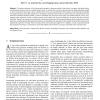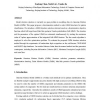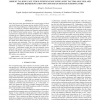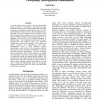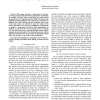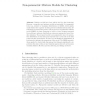TVCG
2012
12 years 10 months ago
2012
—This paper describes a fully automated framework to generate realistic head motion, eye gaze, and eyelid motion simultaneously based on live (or recorded) speech input. Its cent...
IJON
2011
13 years 11 months ago
2011
, Yunde Jia Model structure selection is currently an open problem in modeling data via Gaussian Mixture Models (GMM). This paper proposes a discriminative method to select GMM st...
ICASSP
2011
IEEE
13 years 11 months ago
2011
IEEE
This paper describes the improvement introduced in the Loquendo–Politecnico di Torino (LPT) speaker recognition system submitted to the NIST SRE10 evaluation campaign. This syst...
ICASSP
2011
IEEE
13 years 11 months ago
2011
IEEE
It has been previously demonstrated that systems based on block wise local features and Gaussian mixture models (GMM) are suitable for video based talking face verification due t...
INTERSPEECH
2010
14 years 2 months ago
2010
This paper describes Brno University of Technology (BUT) system for the Interspeech 2010 Paralinguistic Challenge. Our submitted systems for the Age- and Gender-Sub-Challenges emp...
FLAIRS
2009
14 years 5 months ago
2009
As robots become more common, it becomes increasingly useful for them to communicate and effectively share knowledge that they have learned through their individual experiences. L...
ICPR
2010
IEEE
14 years 5 months ago
2010
IEEE
In this paper, we consider speaker identification for the co-channel scenario in which speech mixture from speakers is recorded by one microphone only. The goal is to identify both...
ICDM
2010
IEEE
14 years 5 months ago
2010
IEEE
Abstract--This paper presents a framework for privacypreserving Gaussian Mixture Model computations. Specifically, we consider a scenario where a central service wants to learn the...
SSPR
2010
Springer
14 years 5 months ago
2010
Springer
Mixture models have been widely used for data clustering. However, commonly used mixture models are generally of a parametric form (e.g., mixture of Gaussian distributions or GMM),...
PRL
2007
14 years 7 months ago
2007
Abstract – In this paper we seek a Gaussian mixture model (GMM) of the classconditional densities for plug-in Bayes classification. We propose a method for setting the number of ...
